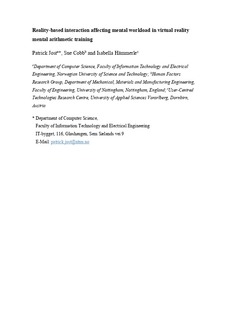| dc.contributor.author | Jost, Patrick | |
| dc.contributor.author | Cobb, Sue | |
| dc.contributor.author | Hämmerle, Isabella | |
| dc.date.accessioned | 2019-10-04T09:23:54Z | |
| dc.date.available | 2019-10-04T09:23:54Z | |
| dc.date.created | 2019-08-25T16:39:13Z | |
| dc.date.issued | 2019 | |
| dc.identifier.citation | Behaviour and Information Technology. 2019, . | nb_NO |
| dc.identifier.issn | 0144-929X | |
| dc.identifier.uri | http://hdl.handle.net/11250/2620267 | |
| dc.description.abstract | The concept of digital game-based learning (DGBL) evolves rapidly together with technological enhancements of virtual reality (VR) and smart phones. However, the mental workload (MWL) that VR-training applications demand and motivational qualities originating from user experience (UX) should be identified in order to create effective and enjoyable training/learning challenges that fit with individual users’ capabilities. This study examined the effects of reality-based interaction (RBI) and VR on measures of student motivation and MWL, in a mental arithmetic game for secondary school pupils. In a randomised controlled trial with sixty school children, a mental arithmetic game was tested with three different interaction and two different presentation methods – VR RBI, VR head-mounted-display tapping and tablet flick-gesture. Results found a significant effect of RBI on MWL but no differences in enjoyment of training were found between VR-experience and tablet training-experience. In fact, adding the gaming-context to the mental arithmetic task created an enjoyable, motivating experience regardless of presentation or interaction-style. | nb_NO |
| dc.language.iso | eng | nb_NO |
| dc.publisher | Taylor & Francis | nb_NO |
| dc.subject | Ergonomi | nb_NO |
| dc.subject | Ergonomics | nb_NO |
| dc.subject | Brukergrensesnitt | nb_NO |
| dc.subject | Human-Computer Interaction | nb_NO |
| dc.subject | Danning | nb_NO |
| dc.subject | Education | nb_NO |
| dc.title | Reality-based interaction affecting mental workload in virtual reality mental arithmetic training | nb_NO |
| dc.type | Journal article | nb_NO |
| dc.type | Peer reviewed | nb_NO |
| dc.description.version | acceptedVersion | nb_NO |
| dc.subject.nsi | VDP::Datateknologi: 551 | nb_NO |
| dc.subject.nsi | VDP::Computer technology: 551 | nb_NO |
| dc.source.pagenumber | 17 | nb_NO |
| dc.source.journal | Behaviour and Information Technology | nb_NO |
| dc.identifier.doi | https://doi.org/10.1080/0144929X.2019.1641228 | |
| dc.identifier.cristin | 1718516 | |
| dc.description.localcode | Locked until 7.8.2020 due to copyright restrictions. This is an [Accepted Manuscript] of an article published by Taylor & Francis in [Behaviour and Information Technology] on [07 Aug 2019], available at https://doi.org/10.1080/0144929X.2019.1641228 | nb_NO |
| cristin.unitcode | 194,63,10,0 | |
| cristin.unitname | Institutt for datateknologi og informatikk | |
| cristin.ispublished | true | |
| cristin.fulltext | postprint | |
| cristin.qualitycode | 1 | |
